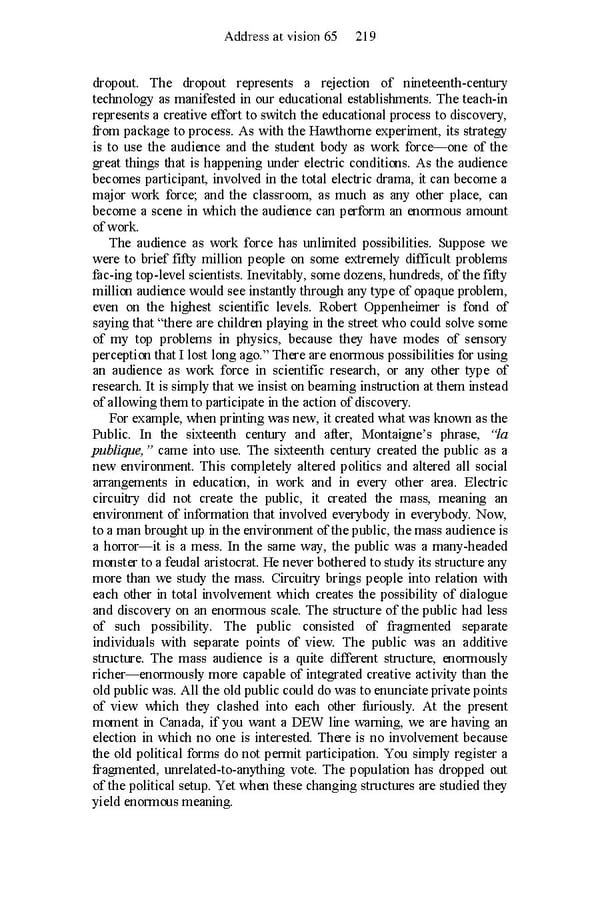Address at vision 65 219 dropout. The dropout represents a rejection of nineteenth-century technology as manifested in our educational establishments. The teach-in represents a creative effort to switch the educational process to discovery, from package to process. As with the Hawthorne experiment, its strategy is to use the audience and the student body as work force—one of the great things that is happening under electric conditions. As the audience becomes participant, involved in the total electric drama, it can become a major work force; and the classroom, as much as any other place, can become a scene in which the audience can perform an enormous amount of work. The audience as work force has unlimited possibilities. Suppose we were to brief fifty million people on some extremely difficult problems fac-ing top-level scientists. Inevitably, some dozens, hundreds, of the fifty million audience would see instantly through any type of opaque problem, even on the highest scientific levels. Robert Oppenheimer is fond of saying that “there are children playing in the street who could solve some of my top problems in physics, because they have modes of sensory perception that I lost long ago.” There are enormous possibilities for using an audience as work force in scientific research, or any other type of research. It is simply that we insist on beaming instruction at them instead of allowing them to participate in the action of discovery. For example, when printing was new, it created what was known as the Public. In the sixteenth century and after, Montaigne’s phrase, “la publique,” came into use. The sixteenth century created the public as a new environment. This completely altered politics and altered all social arrangements in education, in work and in every other area. Electric circuitry did not create the public, it created the mass, meaning an environment of information that involved everybody in everybody. Now, to a man brought up in the environment of the public, the mass audience is a horror—it is a mess. In the same way, the public was a many-headed monster to a feudal aristocrat. He never bothered to study its structure any more than we study the mass. Circuitry brings people into relation with each other in total involvement which creates the possibility of dialogue and discovery on an enormous scale. The structure of the public had less of such possibility. The public consisted of fragmented separate individuals with separate points of view. The public was an additive structure. The mass audience is a quite different structure, enormously richer—enormously more capable of integrated creative activity than the old public was. All the old public could do was to enunciate private points of view which they clashed into each other furiously. At the present moment in Canada, if you want a DEW line warning, we are having an election in which no one is interested. There is no involvement because the old political forms do not permit participation. You simply register a fragmented, unrelated-to-anything vote. The population has dropped out of the political setup. Yet when these changing structures are studied they yield enormous meaning.
 Essential McLuhan Page 225 Page 227
Essential McLuhan Page 225 Page 227